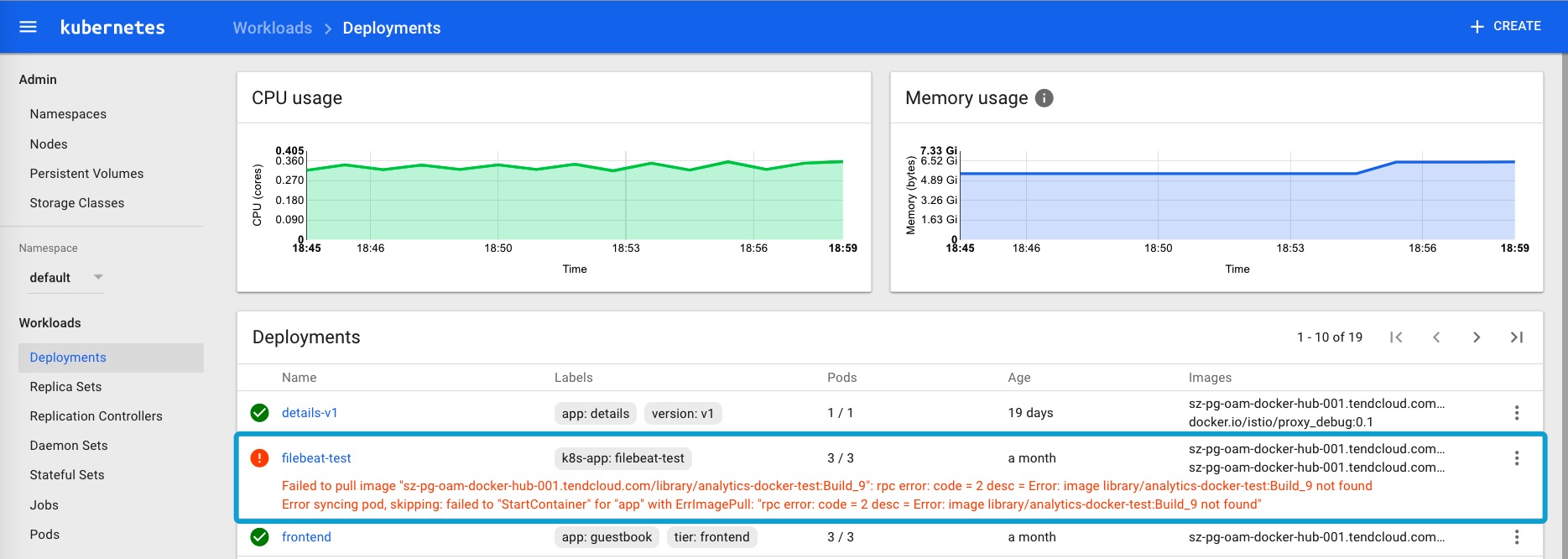9.2 KiB
9.2 KiB
client-go示例
访问kubernetes集群有几下几种方式:
| 方式 | 特点 | 支持者 |
|---|---|---|
| Kubernetes dashboard | 直接通过Web UI进行操作,简单直接,可定制化程度低 | 官方支持 |
| kubectl | 命令行操作,功能最全,但是比较复杂,适合对其进行进一步的分装,定制功能,版本适配最好 | 官方支持 |
| client-go | 从kubernetes的代码中抽离出来的客户端包,简单易用,但需要小心区分kubernetes的API版本 | 官方支持 |
| client-python | python客户端,kubernetes-incubator | 官方支持 |
| Java client | fabric8中的一部分,kubernetes的java客户端 | redhat |
下面,我们基于client-go,对Deployment升级镜像的步骤进行了定制,通过命令行传递一个Deployment的名字、应用容器名和新image名字的方式来升级。代码和使用方式见 https://github.com/rootsongjc/kubernetes-client-go-sample 。
kubernetes-client-go-sample
代码如下:
package main
import (
"flag"
"fmt"
"os"
"path/filepath"
"k8s.io/apimachinery/pkg/api/errors"
metav1 "k8s.io/apimachinery/pkg/apis/meta/v1"
"k8s.io/client-go/kubernetes"
"k8s.io/client-go/tools/clientcmd"
)
func main() {
var kubeconfig *string
if home := homeDir(); home != "" {
kubeconfig = flag.String("kubeconfig", filepath.Join(home, ".kube", "config"), "(optional) absolute path to the kubeconfig file")
} else {
kubeconfig = flag.String("kubeconfig", "", "absolute path to the kubeconfig file")
}
deploymentName := flag.String("deployment", "", "deployment name")
imageName := flag.String("image", "", "new image name")
appName := flag.String("app", "app", "application name")
flag.Parse()
if *deploymentName == "" {
fmt.Println("You must specify the deployment name.")
os.Exit(0)
}
if *imageName == "" {
fmt.Println("You must specify the new image name.")
os.Exit(0)
}
// use the current context in kubeconfig
config, err := clientcmd.BuildConfigFromFlags("", *kubeconfig)
if err != nil {
panic(err.Error())
}
// create the clientset
clientset, err := kubernetes.NewForConfig(config)
if err != nil {
panic(err.Error())
}
deployment, err := clientset.AppsV1beta1().Deployments("default").Get(*deploymentName, metav1.GetOptions{})
if err != nil {
panic(err.Error())
}
if errors.IsNotFound(err) {
fmt.Printf("Deployment not found\n")
} else if statusError, isStatus := err.(*errors.StatusError); isStatus {
fmt.Printf("Error getting deployment%v\n", statusError.ErrStatus.Message)
} else if err != nil {
panic(err.Error())
} else {
fmt.Printf("Found deployment\n")
name := deployment.GetName()
fmt.Println("name ->", name)
containers := &deployment.Spec.Template.Spec.Containers
found := false
for i := range *containers {
c := *containers
if c[i].Name == *appName {
found = true
fmt.Println("Old image ->", c[i].Image)
fmt.Println("New image ->", *imageName)
c[i].Image = *imageName
}
}
if found == false {
fmt.Println("The application container not exist in the deployment pods.")
os.Exit(0)
}
_, err := clientset.AppsV1beta1().Deployments("default").Update(deployment)
if err != nil {
panic(err.Error())
}
}
}
func homeDir() string {
if h := os.Getenv("HOME"); h != "" {
return h
}
return os.Getenv("USERPROFILE") // windows
}
我们使用kubeconfig文件认证连接kubernetes集群,该文件默认的位置是$HOME/.kube/config。
该代码编译后可以直接在kubernetes集群之外,任何一个可以连接到API server的机器上运行。
编译运行
$ go get github.com/rootsongjc/kubernetes-client-go-sample
$ cd $GOPATH/src/github.com/rootsongjc/kubernetes-client-go-sample
$ make
$ ./update-deployment-image -h
Usage of ./update-deployment-image:
-alsologtostderr
log to standard error as well as files
-app string
application name (default "app")
-deployment string
deployment name
-image string
new image name
-kubeconfig string
(optional) absolute path to the kubeconfig file (default "/Users/jimmy/.kube/config")
-log_backtrace_at value
when logging hits line file:N, emit a stack trace
-log_dir string
If non-empty, write log files in this directory
-logtostderr
log to standard error instead of files
-stderrthreshold value
logs at or above this threshold go to stderr
-v value
log level for V logs
-vmodule value
comma-separated list of pattern=N settings for file-filtered logging
使用不存在的image更新
$ ./update-deployment-image -deployment filebeat-test -image harbor-001.jimmysong.io/library/analytics-docker-test:Build_9
Found deployment
name -> filebeat-test
Old image -> harbor-001.jimmysong.io/library/analytics-docker-test:Build_8
New image -> harbor-001.jimmysong.io/library/analytics-docker-test:Build_9
查看Deployment的event。
$ kubectl describe deployment filebeat-test
Name: filebeat-test
Namespace: default
CreationTimestamp: Fri, 19 May 2017 15:12:28 +0800
Labels: k8s-app=filebeat-test
Selector: k8s-app=filebeat-test
Replicas: 2 updated | 3 total | 2 available | 2 unavailable
StrategyType: RollingUpdate
MinReadySeconds: 0
RollingUpdateStrategy: 1 max unavailable, 1 max surge
Conditions:
Type Status Reason
---- ------ ------
Available True MinimumReplicasAvailable
Progressing True ReplicaSetUpdated
OldReplicaSets: filebeat-test-2365467882 (2/2 replicas created)
NewReplicaSet: filebeat-test-2470325483 (2/2 replicas created)
Events:
FirstSeen LastSeen Count From SubObjectPath Type ReasoMessage
--------- -------- ----- ---- ------------- -------- ------------
2h 1m 3 {deployment-controller } Normal ScalingReplicaSet Scaled down replica set filebeat-test-2365467882 to 2
1m 1m 1 {deployment-controller } Normal ScalingReplicaSet Scaled up replica set filebeat-test-2470325483 to 1
1m 1m 1 {deployment-controller } Normal ScalingReplicaSet Scaled up replica set filebeat-test-2470325483 to 2
可以看到老的ReplicaSet从3个replica减少到了2个,有2个使用新配置的replica不可用,目前可用的replica是2个。
这是因为我们指定的镜像不存在,查看Deployment的pod的状态。
$ kubectl get pods -l k8s-app=filebeat-test
NAME READY STATUS RESTARTS AGE
filebeat-test-2365467882-4zwx8 2/2 Running 0 33d
filebeat-test-2365467882-rqskl 2/2 Running 0 33d
filebeat-test-2470325483-6vjbw 1/2 ImagePullBackOff 0 4m
filebeat-test-2470325483-gc14k 1/2 ImagePullBackOff 0 4m
我们可以看到有两个pod正在拉取image。
还原为原先的镜像
将image设置为原来的镜像。
$ ./update-deployment-image -deployment filebeat-test -image harbor-001.jimmysong.io/library/analytics-docker-test:Build_8
Found deployment
name -> filebeat-test
Old image -> harbor-001.jimmysong.io/library/analytics-docker-test:Build_9
New image -> harbor-001.jimmysong.io/library/analytics-docker-test:Build_8
现在再查看Deployment的状态。
$ kubectl describe deployment filebeat-test
Name: filebeat-test
Namespace: default
CreationTimestamp: Fri, 19 May 2017 15:12:28 +0800
Labels: k8s-app=filebeat-test
Selector: k8s-app=filebeat-test
Replicas: 3 updated | 3 total | 3 available | 0 unavailable
StrategyType: RollingUpdate
MinReadySeconds: 0
RollingUpdateStrategy: 1 max unavailable, 1 max surge
Conditions:
Type Status Reason
---- ------ ------
Available True MinimumReplicasAvailable
Progressing True NewReplicaSetAvailable
OldReplicaSets: <none>
NewReplicaSet: filebeat-test-2365467882 (3/3 replicas created)
Events:
FirstSeen LastSeen Count From SubObjectPath Type ReasoMessage
--------- -------- ----- ---- ------------- -------- ------------
2h 8m 3 {deployment-controller } Normal ScalingReplicaSet Scaled down replica set filebeat-test-2365467882 to 2
8m 8m 1 {deployment-controller } Normal ScalingReplicaSet Scaled up replica set filebeat-test-2470325483 to 1
8m 8m 1 {deployment-controller } Normal ScalingReplicaSet Scaled up replica set filebeat-test-2470325483 to 2
2h 1m 3 {deployment-controller } Normal ScalingReplicaSet Scaled up replica set filebeat-test-2365467882 to 3
1m 1m 1 {deployment-controller } Normal ScalingReplicaSet Scaled down replica set filebeat-test-2470325483 to 0
可以看到available的replica个数恢复成3了。
其实在使用该命令的过程中,通过kubernetes dashboard的页面上查看Deployment的状态更直观,更加方便故障排查。
这也是dashboard最大的优势,简单、直接、高效。
